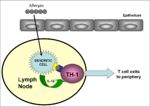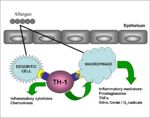Type IV Hypersensitivity
Revision as of 13:54, 26 August 2008 by Mmadment (talk | contribs) (New page: ==Type IV Hypersensitivity== [[Image:Sensitisation phase Type IV Hypersensitivity.jpg|right|thumb|150px|Sensitisation phase: Type VI hypersensitiv...)
Type IV Hypersensitivity
Cell mediated hypersensitivity:
Exposure to antigen causes CD4+ T helper cells to be activated leading to colonal expansion (takes 1-2 weeks). On subsiquent exposure with the same antigen sensitised CD4+ T helper cells secrete cytokines which attract and activate macrophages. The macrophages have an increased ability to phagocytose pathogens, which is very important for the clearance of intracellular pathogens. However if antigen persists, the lytic products of the macrophages can damage healthy tissues.
Involves TH-1 releasing cytokines which activate macrophages and other T cells.
- CD4+ T cell mediated:
- Abnormal activation of macrophages in healthy tissues.
- Macrophage production of inflammatory mediators and MMP enzymes cause tissue damage.
- CD8+ T cell mediated:
- Cytotoxic T lymphocytes (CTLs) kill healthy cells mistakenly thinking they are infected by a virus.
3 types:
Contact
- Involves simple chemicals (antigens) which bind to skin proteins:
- Nickle
- Rubber
- Poison ivy
Distinguishing contact from immediate hypersensitivity
| Atopic dermatitis | Contact dermatitis | |
|---|---|---|
| Pathogenesis | Type I | Type II |
| Time | 20 mins | 24-48 hours |
| Distribution | face, nose, eyes, feet, perineum | hairless regions |
| Antigens | foods, pollens, fleas, inhaled allergens | chemicals, dyes |
| Diagnosis | "prick" test | patch test for delayed hypersensitivity |
| Pathology | mast cells, eosinophils | mononuclear cells |
Granulomatous
- Intense activation of T cells, cytokine release and macrophage activation cause necrosis of surrounding tissue, granuloma formation leading to destruction of host tissue.
- Composed of epithelial cell, giant cells and macrophages in response to infection, for example:
- Mycobacterium tubercle
- Schistosome eggs
- Granulomas can obstruct normal organ function:
- Lungs: fills up with cells leading to impaired function
- Brain/liver: very severe
Tuberculin test
- Injection of intradermal antigen into the skin.
- A skin reaction (infiltration of lymphocytes and monocytes) peaking at 48-72 hours indicates prior exposure to the antigen or ongoing infection.
- It is used for TB testing cattle; the antigen is purified protein derivative-PPD from Mycobacterium tuberculosis.
- Presently in the UK the animal is culled if it has a positive skin reaction.

